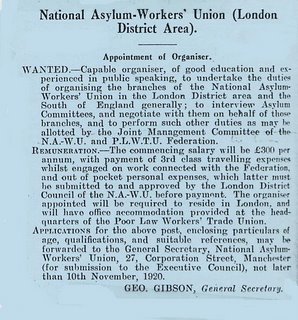Gay Lee (article Hospital Worker 1981 )

Monday, September 25, 2006
Radical Nurses Group (estb 1980)
Gay Lee (article Hospital Worker 1981 )
COHSE Officers 1982
COHSE OFFICERS MAY 1982
National President - Sid Ambler
Vice President - Colin Robinson
COHSE Head Office
Glen House, High Street, Banstead,
General Secretary - Albert Spanswick
Asst General Secretary - David Williams
National Officers
Hector Mackenzie
Colm O’Kane
Terry Mallinson
Rose Lambie
Finance Officer - Robert Farthing
Deputy Finance Officer - Bill Turner
Conference Office - Bill Loftus
Research Officer - Nick Grant
Legal Officer - Alex Heron
Education Officer - Malcolm MacMillan
Press Officer - Nita Clarke
Admin Asst - Joan Reed
Admin Asst - Vivienne Green
Admin Asst - Kitty Tobin
COHSE REGIONS
No. 1 (Northern)
44-46 Grosvenor Road, Jesmond, Newcastle-upon-Tyne 2
Regional Secretary: Andy Vanbeck
Regional Officers: Lisa Brady, Keith Blackburn
No. 2 (Yorkshire and Humberside)
98 Mansfield Road, Intake, Sheffield
Regional Secreatry :Martin Kineavy
Regional Officers: Glyn Robinson, Jean Moxon
No. 3 (North-Western)
381 Bury New Road, Prestwich. Manchester M25 5AW
Regional Secretary :Eric Cooper
Regional Officers: Bob Quick, Terry Foster, Andy Gill
No. 4 (West Midlands)
Dartmouth House, 67 Birmingham Road, West Bromwich, Staffs.
Regional Secretary: Bob Wilshaw
Regional Officers: Leslie Bumford, PaulVaughan
No. 5 (North-East Thames and East Anglia)
42-44 Sewardstone Road, Chingford, London E4 7JW
Regional Secretary: Keith Taylor
Regional Officers: John Wright, Pat Gormley
No. 6 (North-West Thames and
Regional Secretary: Pat McGinley
Regional Officers: Ernie Brook, Niall Sheridan
No. 7 (South-Western)
Silverlea House. 4 Billetfield,
Regional Secretary: Ty Taylor
Regional Officers: Trevor Wiggins,Trevor Parsons
No. 8 (
Regional Secretary: Bob Harmes
Regional Officers: John Jaggon, Fiona Sloman
No. 9 (
Also
75 Abbeygreen, Lesmahagow, Lanarkshire
Regional Secretary: Keith Hickson
Regional Officers Bert Dickson, Jimmy Mc Phee
No. 10 (Wales)
32 Gelliwastad Road, Pontypridd, Glamorgan.
Regional Secretary: Ted Davies
Regional Officers: Dick Edwards. Dave Galligan
No. 11 (
Regional Secretary : Bill Jackson
Regional Officers: Tommy Hughes. Hugh Miskelly
No. 12 (
98 Mansfield Road, Intake, Sheffield
Regional Secretary: Keith Swiffen
Regional Officers: Chris Binks. Terry Kelly
No. 13 (South-West Thames and
also
Regional Secretary: lan Dodd
Regional Officers: Judith Carter, Bob Abberley
Sunday, September 24, 2006
COHSE Strike Plan 1982

The COHSE NEC Action Plan
The Action Committee set up by COHSE's National Executive Committee met on
The two main forms to be applied within the COHSE guidelines on the protection of patient care and maintenance of emergency services are:
•ban on all non-emergency admissions;
• selective two hour withdrawals of Labour.
A further list was also set out, again within COHSE's Code of Conduct and within the 1979 Joint Agreement on Emergency Services. The proposals, as well as the emergency services agreement, are listed in Head Office Circular 235/82.
Designed to cause the greatest administrative inconvenience to management and least harm to patients, they include:
• ban on private patients' services;
• non co-operation with private contractors;
•refusal by nurses to carry out non-nursing duties, as well as by non-nurses to carry out nursing duties;
•ban on the cleaning of non-clinical areas;
•reduction of output of hospital laundries;
•holding of local demonstrations;
RCN "no opposition" to contacting out - 1989

CONTRACTING OUT OF SERVICES FROM THE NHS
ADVICE PACK FOR RCN MEMBERS
June 1989
WHAT THE POLICY MEANS IN PRACTICE
1. The role of competitive tendering in the NHS
The RCN stance on competitive tendering means that there is no opposition in principle to the concept of contracting out. The College accepts that there may be areas where efficiency savings and/or improvements to services can be made, and that the process of competitive tendering may assist with this. However, it is paramount that the standard of patient care must be at least maintained, and preferably improved. The generation of savings cannot be considered in isolation from other effects of competitive tendering.
The RCN policy aims to ensure that all aspects of services are considered, and that decisions on contracts are based on professional assessment of overall quality of service to patients, not on purely financial grounds.
Experience in the NHS to date has shown that the risk of contracting out is such that the RCN believes it can only be justified if substantial amounts of money are saved and used to the direct benefit of patient care.
NOTE:
This “blinkered” RCN position lead the local RCN officer during the Hillingdon hospital domestic dispute to state that it had nothing to do with nursing
THE NUPE CHARTER FOR MENTAL HOSPITAL EMPLOYEES (1938)
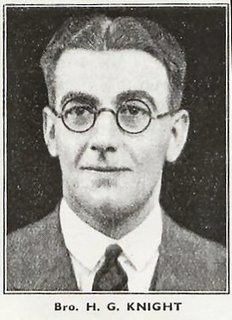
THE NUPE CHARTER FOR MENTAL HOSPITAL EMPLOYEES (1938)
By
1. Hours of DUTY – 96 hour fortnight with complete elimination of the spread-over system
2. OVERTIME – To rank for special duty pay, and “time in lieu” to be discouraged.
3. ANNUAL LEAVE - Indoor Staff: A minimum of one month with full pay; additional leave to be granted in special cases. Outdoor Staff: A minimum of three weeks with full pay.
4. SICK PAY - A minimum of 13 weeks full and 13 weeks half-pay, with extension at the discretion of the Committee. Periods of sickness or accident due to service to be paid at full-salary scale during the whole period absent from duty.
5. PERMANENT DISABILITY - Adequate compensation should be paid in cases of permanent disability arising from cases of disease, illness or injury contracted or sustained during the normal course of duty.
6. RATES OF PAY - Complete revision of present rates of pay and incremental scales.
7. NURSES' HOMES - Nurses should have freedom of choice regarding place of residence, but when Nurses' Homes are established, full amenities for privacy to be provided. Indoor and outdoor facilities for study and recreation.
8. HIGHER GRADE PAYMENTS - Payment for all higher grade duties to commence from the time the duties are undertaken.
9. AFTER-DUTY PASSES - Resident Staff to be brought into conformity with this regulation in the L.C.C. Public Health Department.
10. RESTRICTIONS. - The abolition of all unnecessary restrictions.
If you agree with this Charter and are not already a member of an active trade union, join N.U.P.E. to-day and let us get on with the job.
NUPE Journal June 1938
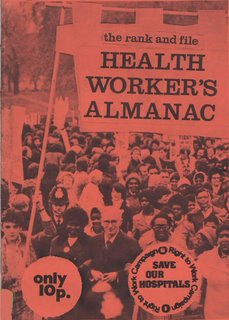
Hospital Workers Charter
(Circa 1977)
AGAINST ALL CUTS - DEFEND AND IMPROVE THE NHS
No cuts in staff at any level
No cover of unfilled vacancies
No jobs lost : for all trained Hospital Workers
For the improvement of our buildings, facilities and equipment.
NHS staff to replace all voluntary workers , agency workers and outside contractors.
All hospital workers fighting the cuts should campaign in the local TU movement for active support.
WAGES AND CONDITIONS
Against all loss of earnings through cuts in overtime and bonus levels; For a decent living wage for all Hospital Workers.
Against all forms of pay restraint.
For a 35 hour week; without loss of pay, To force more jobs.
FOR
For 100% Trade Union organisation
Monthly branch meetings in working time
Shop Stewards regularly elected for every department at departmental meetings
No participation in Joint Consultative Committees: for the building of strong Joint Shop Stewards Committees at Hospital, district and area level.
FOR UNION DEMOCRACY
Annual national conferences to be the supreme policy making body
Full-time union officials to be elected annually by the members, on the same pay as the members, and recallable by their members at any time.
SPECIAL DEMANDS
Against all racial discrimination
For the automatic renewal of work permits
For the abolition of private practice inside and outside the NHS
NOTE:
Hospital Worker was primarily a publication of the Socialist Workers Party established in 1973 at conference in Birmingham. In 1975 it dissolved national editions into regionaal broadsheets, but a new national bulliten was re-established in October 1976 which survived until about 1982
By the early 1980’s, the SWP’s increasing sectarianism and famous “down turn period” forced it’s closure.
MH&IWU Nurses Charter (1945)
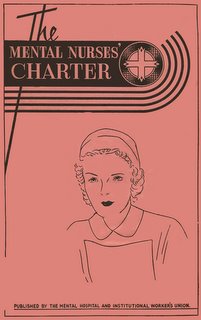
Mental Hospital & Instutional Workers
Mental Nurses Charter (1945)
FOREWORD.
Owing to the acute shortage of nurses and the dearth of recruits to the Nursing Service, the General Secretary of the Mental Hospital and Institutional Workers' Union, as a member of the T.U.C. General Council, presented to the Trades Union Congress (1937) the Nurses' Charter, which focused public attention on the necessity of improving salaries and conditions of service in the Nursing Profession.
The Government set' up an Inter-Departmental Committee under the Chairmanship of Lord Alness,
"To inquire into the arrangements at present in operation in Scotland with regard to the recruitment and terms and conditions of service of persons engaged in nursing the sick, and to report whether-any changes in these arrangements, or other measures, are expedient for the purpose of maintaining an adequate service, both for institutional and for domiciliary nursing."
This Committee issued a report to the Department of Health for
In October, 1941, the Right Hon. Thomas Johnston, M.P., Secretary of State for
"To draw up agreed scales of salaries and emoluments for State-registered nurses employed in
In November, 1942, it was decided to set up a Sub-Committee in association with the Nurses' Salaries Committee to make a rapid review of the scales of salaries and conditions of service in Mental Hospitals and Institutions in
The salaries and conditions of service agreed by this Sub-Committee were accepted as the terms of employment under the Mental Nurses (Employment and Offences) Order (Scotland), 1943, on the understanding that another Sub-Committee of the Scottish Nurses' Salaries Committee would be set up to deal with many aspects of terms and conditions of service which had not been previously dealt with.
The Secretary of State for
should be set up
"To draw up agreed scales of salaries and conditions of service of nurses in Mental Hospitals and Mental Deficiency Institutions in the light of the recommendations made by the Taylor Committee."
The Sub-Committee consisted of 12 members on each of two panels representing employers and employees, and their first meeting was held on January 14th, 1944, and the last meeting was held on June 14th, 1945.
Throughout the proceedings of the Sub-Committee the following Union representatives attended meetings :—
Mr; GEO. GIBSON (Gen. Sec.) Mr. J. BUTLER (N.E.C.)
Mr. H. SHAW (Assist. Gen. Sec.) Mr. T. PRENTICE (Scot. Fed. Sec.)
Mr. J. T. WAITE (Nat. Organiser) Mr. J. RUSSELL (Cupar Branch)
Mr. M. MCBRIDE (Scot. Organiser} Miss A. M. HOWIE (Woodilee B.)
This publication is not a full report of the Sub-Committee's decisions, although the main features of the recommendations are given in detail for the guidance of all Mental Nurses in
Saturday, September 23, 2006
Pete Marshall
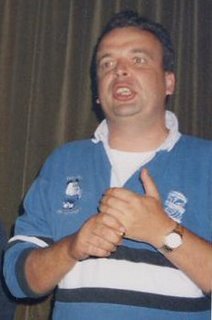
Pete Marshall started his nursing career at St Margaret’s hospital in
He was a keen advocate of progressive policies with regard to the mentally handicapped. He soon became involved in the local COHSE branch becoming its Assistant Branch Secretary and publicity officer.
Pete, along with his close friend Andy Stackhouse organised a very high profile campaign regarding staffing levels at the hospital, which culminated in a huge vote of no confidence in the hospitals senior management.
Pete Marshall was appointed COHSE regional officer for North Thames & Oxford region of COHSE in May 1984, securing a high level of popularity amongst the COHSE activists on his patch.
He soon secured a high profile in the
In the mid 1980's, Pete along with Bob Abberley were key in pushing through a mayor review of COHSE’s policies with regard to the Mentally Handicapped services (Learning difficulties). This led the union into having a progressive view with regard to the closure of the old large Victorian institutions. Without this progressive view COHSE would not only have lost new professionals entering this field, but more importantly could have seriously undermined any move to the community facilities.
Pete was a committed anti racists and fascist and was involved the infamous “Battle of
Pete was elected to the Executive of the Greater London Labour Party and was a close associate of Jim Fitzpatrick (later MP for Bow & Poplar).
In June 1990 Pete was appointed Regional Secretary for the new COHSE London region, but on appointment stated in typical style that his best job was “renting deck chairs out on Bourenmouth beach”.
After the creation of UNISON in 1993, Pete struggled with the new channels of accountability, famously denouncing the wrong right winger in Labour Briefing earning him a famous but hilarious rebuke from Rodney Bickerstaffe General Secretary.
Pete turned down the opportunity to head up health in the capital and moved into UNISON’s energy sector finally moving back to the
Friday, September 22, 2006
COHSE No Cuts in 1987

COHSE Conference 1986 Report
COHSE members are looking to turn 1987 into “No cuts year” with a large –scale centrally directed campaign to defend the Health & Social Services.
That was the message from Chris Hart of Maudsley Branch moving Resolution 55. He said: 'We are asking for a campaign run along similar lines to the political fund.
campaign. 'We want to use the media of all forms. We want videos, leaflets, meetings for members of the public and for health workers.'.
And he urged delegates: 'Take this resolution back to your members, take it to
every region and carry on the campaign.'
He was backed by Jean Winship of Bethlem Royal, who said: 'The public doesn’t'
know the true facts.' And she outlined the savage cuts in staffing, pay and conditions in the hospitals.
The resolution was accepted for the NEC by General Secretary David Williams, who urged: 'Don't vote for the resolution and then forget it. Vote for it and then do something about it.” And he went on: 'Here is a wonderful resolution that can unite us in action in campaign.'
COHSE had given full support to miners in their fight, and it had played an
active role in other workers battles, we have supported every working class struggle there is,' he said. Now COHSE had the opportunity to fight united against the cuts.
The resolution was CARRIED.
Conference also backed a call by Cllr Michael Walker of Hillingdon and District Branch, moving Resolution 56, to support London Health Emergency. LHE, he said, was a model of how to run a campaign. And he told delegates: 'COHSE has played an important role and we are proud of the work we have done.'
Bill Nimmo of
David Williams, for the NEC, promised that COHSE would continue to give its
support to LHE. The resolution was CARRIED.
NOTE:
While the COHSE no cuts campaign meet with mixed success, it undoubtedly increased the national profile of COHSE and possibly contributed to the confidence amongst the more advanced elements of the membership. Leading to the successful strike action by COHSE nurses in 1988. A dispute which rocked the Thatcher government and secured major pay rises for nurses.
National Asylum Workers Union Branches 1911
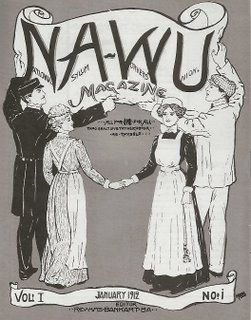
National Asylum Workers Union Branches 1911 (December 1911)
ASYLUM MEMBERS PERCENTAGE OF WORKFORCE
Abergavenny (Wales) 72 members 64% of staff
Aylesbury 59 members 59% of staff
Banstead 82 members 26% of staff
Beverley 20 members
Bexley 180 members 50% of staff (94% of male staff)
Bodmin 94 members 52% of staff
Cane Hill 149 members 53% of staff
Caterham 121 members 35% of staff
Claybury 145 members 35% of staff
Colney Hatch 104 members 27% of staff
Cotford 63 members 63% of staff
Darenth 186 members 70% of staff
Devizes 110 members 71% of staff
Epsom 279 members 45% of staff
Exminister 138 members 76% of staff
Gloucster 75 members
Hanwell 56 members 19% of staff
Haywards Heath 89 members 68% of staff
Hellingly 117 members 59% of staff (83% of male staff)
Hull 60 members 62% of staff (97% of male staff)
Leavesden 181 members 52% of staff (78% of male staff)
Littlemore 68 members 50% of staff
Macclesfield 150 members
Menston & Scaleboro 225 members 78% of staff (85% of male staff)
Middlesex 75 members 36% of staff
Morpeth 38 members 31% of staff
Netherne 62 members 33% of staff (70% of male staff)
Prestwich 310 members 86% of staff (92% of male staff)
Rainhill 228 members 75% of staff (86% of male staff)
Storthes Hall 149 members 84% of staff
Warlingham 84 members 62% of staff (89% of male staff0
Winwick 245 members 58% of staff (80% of male staff)
also
CENTRAL BRANCH
Fulbourne 31 members 36% of staff
Narboro 18 members
Powick 12 members
Tooting Bec 44 members (63% of male staff
COHSE Officer 1947

COHSE Officer 1947
Claude Bartlett – COHSE President ;
R. Baker – COHSE Vice President Hillcroft,
George Gibson – COHSE General Secretary; 1 Rushford Avenue, Levenshume,
Fred Comer – COHSE Asst General Secretary; Swinton House,
Robert Farthing – COHSE Cashier
Jack. T. Waite – COHSE National Organiser (based Manchester)
**********************************
REGIONAL SECRETARIES:
Cllr George.C. Esther – Northern Region 1
Cllr Jack Jepson – North Eastern Region 2
Ted. A Hardy – North East Region 3
1 Rusholme Avenue, Levenshulme, Manchester.
W.L.Griffiths - North
Joe Richards - Eastern Region 5
155 Old church Road, Romford,
Charles Harris - South West Region 8, Southern Region 9, South Seat Region
Cliff Comer -
Michael McBride - Scotland Region 12
21 Holyrood Crescent, Glasgow,Scotland
Doris Westmacott - COHSE Guild of Nurses
Fred Rason -Voluntary Hospitals
Swinton House,
Members of Parliament
Alderman Ted A. Hardy
Dr Hyacinth Morgan
Dr S (Santo?) Jeger
Fred Messer
George Thomas
TUC – George Gibson
General Nursing Council Miss K. M. Willis, Caterham,mental hospital Surrey Mr J.H.Buckley, 48 Hitchin Road, Arlesey, Bedfordshire
COHSE National Executive Committee 1947
R. Barker; J. Butler; C.E. Ceeley; M.Dubury; A. Flanagam; J. Garside; J. Gue; A. Harrison; J. Hickie; G. Lee; E. Machin; Dr H.B.W. Morgan; E.J. Smart; A.F. Soutwell; H.S. Waites; T.G. Westcott
(J.Gue - Joe Gue Claybury)
Rose Lambie
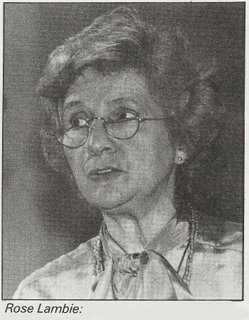
Rose Lambie
Rose Lambie was born into a Scottish mining community in around 1926, the daughter of a miner, a pedigree she was very proud to recall.
Rose commenced work at
Rose gained her trade union education through the National Council of Labour Colleges and sat as an employee representative on the National Insurance Local Appeals Tribunal panel in Motherwell from 1952-1962.
In 1962 Rose moved to work for three years as a senior clerk in the Dietetic office at
Rose Lambie was appointed to the post of COHSE women’s officer In 1965, on the retirement of Doris Westmacott .
She strongly felt that the post of Women’s officer was seen as “inferior” to that of a national officer and therefore fought to be re-graded as a national officer (and opposed women’s officer posts in the union).
As a national officer she took responsibility at various times for Professional & Technical and COHSE’s small but vocal Local Government members (notably in
Rose was involved in COHSE first working party to examine women’s role in the union, which was established in the mid 1970’s but this was wound up in 1976 after two years, primarily because of hostility to its reports at COHSE national delegate conference “It didn’t go down well at conference” she recalled.
Another attempt was made in 1979 to reestablish an equal opportunities committee and with the support of Liz Hooper NEC member and Chair of the Committee (also Braintree Labour Councillor) much progress was made and many of the committee’s recommendations on encouraging women’s participation were adopted by the union. (COHSE was one of the few unions to have reserved NEC seats for women from the 1980’s onwards)
Rose stood unsuccessfully for the post of COHSE General Secretary in 1982 on the death of Albert Spanswick.
She was also the TUC representative on the governing Council of Hillcourt College in
After retirement Rose moved back to Scotland (?) and died only a few weeks after Colm O’Kane in 2005.
Kathleen Daly First COHSE Women Regional Secretary
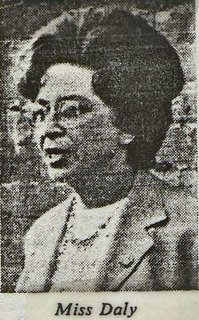
Kathleen Mary Daly First Women to become a COHSE Regional Secretary
Miss Kathleen Daly, Joined the National Union of County Officers in 1932, in 1935 started work as a probationary nurse, the later in many health occupations including, clerk, laundry worker, porter, telephonist and finally ward orderly (unqualified nurse) and was elected COHSE branch secretary at St Giles Hospital, Camberwell,
Represented COHSE on various Whitley Council negotiating bodies.
In 1959 Miss Kathleen Daly was appointed as the first women COHSE Regional Secretary (the only other COHSE Regional Secretary being Gill Hale in the COHSE Northern Region).
She was well respected by COHSE ambulance members in
Kathleen Daly stood for the post of COHSE General Secretary in 1967, However, a year later it was reported to COHSE West Metropolitan Region that Miss Daly was ill and unlikely to return to work.
Thursday, September 21, 2006
Colm O'Kane
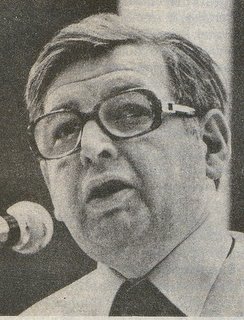
Rev Stanley Morgan 1870-1951
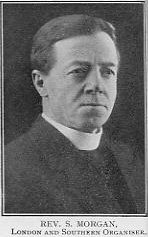
Rev Stanley J.W. Morgan
The COHSE General Secretary Cliff Comer also a staunch non-conformist stated on his death
Comer also recalled Rev Stanley Morgan stating “Comer the world is mad, It will neither have Jesus Christ, nor a sensible economic system to live under”.
